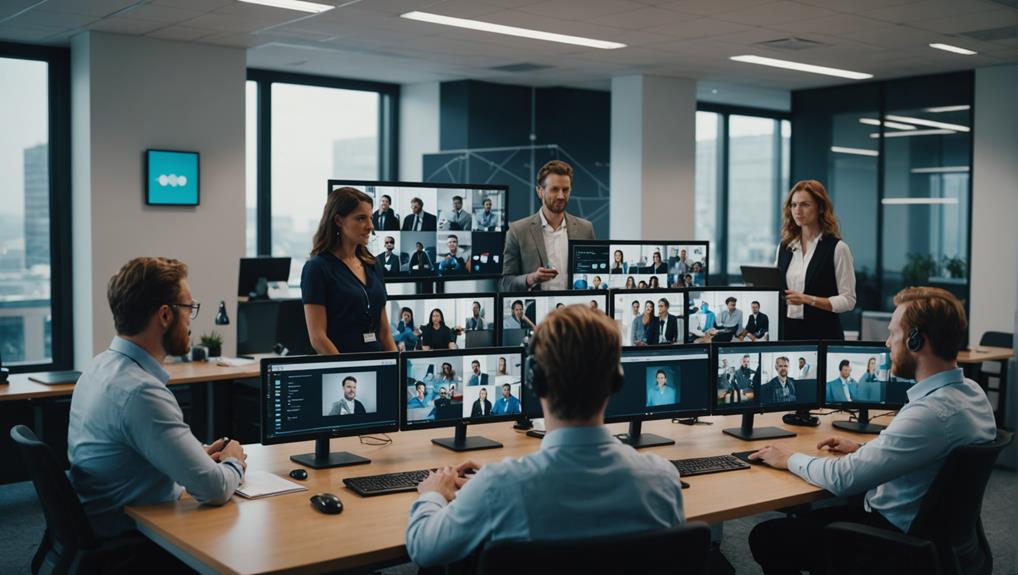Overcoming Communication Barriers in Post-Merger Integration

Overcoming communication barriers in post-merger integration holds significant importance. Establishing transparent communication channels is key.
Utilizing emails for detailed information dissemination, town hall meetings for direct leadership engagement, and regular team meetings for alignment are crucial steps.
Real-time collaboration tools like Slack and Zoom can enhance teamwork, while project management software aids in task organization.
Assessing cultural differences and implementing tailored communication strategies ensures harmonious integration.
Active involvement of key stakeholders through consistent updates and feedback mechanisms is vital for their support and engagement.
By focusing on these strategies, organizations can successfully navigate the complexities of merging entities, leading to seamless integration and improved operational efficiency.
For more in-depth insights and effective techniques, continue exploring this critical topic.
Key Takeaways
- Establishing consistent communication channels such as email, town hall meetings, and internal portals is crucial for effective information dissemination during post-merger integration.
- Utilizing advanced tools like Slack, Microsoft Teams, and project management software can facilitate real-time interaction and task coordination, enhancing overall communication efficiency.
- Regular culture assessments should be conducted to tailor communication strategies effectively and address any cultural differences that may arise during the integration process.
- Engaging key stakeholders through regular updates and involving them in decision-making processes are essential steps to secure their support and foster collaboration.
- Implementing feedback mechanisms to gather and incorporate stakeholder perspectives can help ensure alignment and mitigate misunderstandings, ultimately contributing to a smoother integration process.
Identifying Common Barriers

One common hurdle in post-merger integration is the absence of clear communication, leading to uncertainty and distrust among employees. Navigating the intricate terrain of merging entities becomes challenging when the details of the merger are ambiguous, creating significant communication barriers. This lack of clarity often leaves employees unsure about their roles and the company's future, fostering increased distrust and diminished morale.
Poor communication can also trigger delays and misunderstandings, further complicating the integration process. These delays may result in operational inefficiencies and resistance to change, as employees might be hesitant to embrace new procedures or collaborate with new colleagues. It's crucial to acknowledge that inadequate communication is frequently cited as a primary reason for the failure of mergers and acquisitions.
To tackle these obstacles, proactive measures are essential. Conducting regular meetings, town halls, and providing email updates can help alleviate employee uncertainty and foster trust. By maintaining transparent communication channels, we can address concerns promptly and reduce the ambiguity often associated with mergers. This approach not only facilitates a smoother transition but also promotes innovation and collaboration, crucial elements for a successful post-merger integration.
Establishing Clear Channels
Establishing effective communication channels is crucial for overcoming obstacles and ensuring a successful post-merger integration. Clear channels help prevent misunderstandings, confusion, and disengagement, fostering transparency, trust, and alignment among all parties involved.
By creating designated channels for different types of communication, we can streamline the integration process and ensure that information flows effectively.
- Email: Use email for detailed information and formal documentation sharing.
- Town Halls: Conduct town hall meetings to enable direct interaction with leadership, promoting transparency and building trust.
- Regular Check-ins: Schedule consistent meetings with teams to maintain alignment and address concerns promptly.
- Internal Portals: Utilize internal portals as centralized platforms for essential document storage and updates.
Employing a variety of communication channels ensures that information reaches all stakeholders, accommodating diverse communication preferences and needs. It's essential to uphold these clear channels to maintain trust and alignment, facilitating a smooth transition.
Leveraging Communication Tools

Expanding on the groundwork of clear communication channels, we can harness advanced tools like Slack, Microsoft Teams, and Zoom to facilitate real-time interactions and enhance collaboration across teams. These communication platforms help us transcend geographical barriers, ensuring that every team member stays engaged and in the loop. Zoom's video conferencing feature enables us to conduct virtual meetings, fostering collaboration and ensuring alignment on goals and strategies.
Moreover, project management software such as Asana and Trello can streamline communication, task assignments, and track progress throughout the integration process. These tools serve as a centralized hub for managing projects, minimizing misunderstandings, and keeping everyone aligned.
In addition, regular email newsletters or updates are crucial for disseminating vital information, updates, and announcements to all stakeholders involved in the merger. This practice guarantees that everyone, from top-level executives to frontline employees, remains up-to-date on the latest developments.
Lastly, collaborative document sharing platforms like Google Drive or Dropbox facilitate seamless sharing of documents, reports, and information across teams. These platforms bolster our capacity to work together efficiently, promoting transparency and minimizing the risk of miscommunication. By leveraging these tools, we can overcome communication barriers and drive successful post-merger integration.
Addressing Cultural Differences
Understanding and addressing cultural differences is vital for a successful post-merger integration. When two companies combine, their distinct cultures can create communication barriers that hinder a seamless blending.
To tackle these integration challenges effectively, it's crucial to prioritize cultural alignment and utilize strategic methodologies.
To begin, conducting comprehensive culture assessments is key to identifying significant differences and similarities between the merging entities. These assessments provide valuable insights into the existing cultural landscape, enabling the development of targeted communication plans to address and bridge cultural gaps.
By tailoring communication strategies to specific cultural nuances, organizations can promote alignment and cohesion during the integration process.
Moreover, the implementation of robust change management strategies plays a pivotal role in facilitating cultural alignment post-merger. By employing effective change management techniques, organizations can navigate cultural differences and ensure that all stakeholders are aligned and working towards shared goals.
Dedicated change management experts should be assigned to oversee the integration process, focusing specifically on cultural alignment and addressing any barriers that may arise.
By emphasizing effective communication as the cornerstone of the integration process, organizations can overcome challenges and promote a smooth blending of cultures.
Engaging Key Stakeholders

To ensure a seamless post-merger integration, it's crucial to actively involve essential stakeholders from both organizations. Building collaboration and securing support begins with clear communication, which is vital for addressing concerns, fostering trust, and managing expectations. By aligning communication strategies with the needs and preferences of stakeholders, we can boost engagement and reduce resistance to change.
Keeping stakeholders informed and engaged through regular updates is key. Tailored communications should be utilized to ensure that messages resonate with various audiences. This approach not only maintains everyone on the same page but also cultivates a sense of ownership and dedication to the integration process.
Implementing feedback mechanisms enables us to listen to stakeholders' perspectives and adjust our strategies accordingly. Engaging key stakeholders goes beyond mere informing; it entails actively involving them in decision-making and valuing their input. This collaborative approach helps mitigate potential conflicts and align objectives seamlessly.
Frequently Asked Questions
What Are the Four C's of Post-Merger Integration?
The four essential components of successful post-merger integration are communication, culture, change management, and collaboration. These pillars ensure that leaders are on the same page, employees are fully engaged, cultures are harmonized, key talents are retained, brands are smoothly integrated, stakeholders are onboard, systems are streamlined, visions are aligned, and conflicts are effectively resolved.
Effective communication is crucial during post-merger integration to ensure that all stakeholders are informed, engaged, and aligned with the new direction of the combined entity. Clear and transparent communication helps build trust, manage expectations, and mitigate uncertainties that often arise during such transitions.
Culture plays a significant role in post-merger integration, as it shapes the way employees work together, make decisions, and interact with one another. By addressing cultural differences and finding common ground, organizations can create a cohesive and collaborative environment where employees from both sides feel valued and motivated to contribute to the shared goals.
Change management is essential to navigate the complexities of merging two different organizations and ensuring a smooth transition for all involved. By providing support, training, and resources to help employees adapt to new processes and ways of working, organizations can minimize resistance and maximize the benefits of the merger.
Collaboration is key to leveraging the strengths of both organizations and driving innovation and growth post-merger. By fostering a culture of teamwork, knowledge sharing, and mutual respect, organizations can capitalize on the diverse perspectives and expertise brought together through the merger, leading to greater success and sustainable competitive advantage.
What Are the Challenges of Post-Merger Integration?
Post-merger integration challenges can be overwhelming, impacting various aspects of the newly merged entity. These challenges include managing shifts in leadership, aligning different organizational structures, retaining key talent, integrating technology systems, maintaining the identity of the brand, ensuring customer loyalty, harmonizing operational processes, meeting regulatory requirements, and managing financial reporting. Amidst all this, it's crucial to boost employee morale to navigate through these challenges successfully.
What Would You Do to Overcome the Language and Cultural Difficulties After Merger?
To tackle the language and cultural barriers post-merger, we will introduce comprehensive training programs, immersive workshops focusing on cultural awareness, language classes tailored to the specific needs of the newly integrated teams, and engaging team-building activities. These initiatives will foster a more cohesive and harmonious work environment, encouraging collaboration and understanding among employees from diverse backgrounds.
Moreover, we will provide access to bilingual support, professional interpreting services for crucial meetings or discussions, dedicated cultural mediators to resolve any conflicts or misunderstandings, language exchange programs to facilitate communication and relationship-building, and relocation assistance for employees who may need additional support during this transition period.
What Are the Key Strategies for Success in Managing Internal Communications During a Merger Acquisition?
To excel in managing internal communications during a merger, it is essential to prioritize employee engagement by providing clear and transparent updates. This fosters a sense of trust and inclusivity among employees, ensuring they feel informed and valued throughout the integration process. Additionally, aligning leadership teams from both organizations is crucial for maintaining consistency in messaging and strategic direction.
Establishing feedback mechanisms is key to understanding the concerns and perspectives of employees at all levels. This two-way communication approach allows for issues to be addressed promptly and for employees to feel heard and involved in the decision-making process. Furthermore, appointing change ambassadors within the organization can help drive communication efforts and facilitate smooth transitions during the merger.
Consistent messaging is vital for avoiding confusion and maintaining a sense of stability among employees. Regular stakeholder meetings, whether virtual or in person, provide a platform for sharing updates, addressing questions, and reinforcing the vision and goals of the merger. Integration teams play a crucial role in facilitating communication channels and ensuring that information flows seamlessly across departments and teams.
Conclusion
We successfully tackled the challenges of post-merger integration by:
- Recognizing common obstacles.
- Establishing transparent communication channels.
- Utilizing effective communication tools.
- Addressing cultural disparities.
- Engaging key stakeholders.
By prioritizing these crucial aspects, we aren't merely merging companies; we're harmonizing diverse perspectives into a cohesive symphony.
Let's embrace these strategies to ensure our path towards seamless integration remains smooth, fostering a more robust and unified organization.
Together, we can turn potential disorder into a symphony of triumph.
